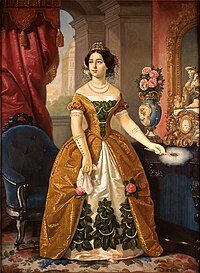Juan Cordero

Juan Nepomuceno María Bernabé del Corazón de Jesús Cordero de Hoyos (16 May 1824, Teziutlán - 29 May 1884, Coyoacán) was a Mexican painter and muralist in the Classical style, who began his career in Rome and Florence.
Biography
His parents originally expected him to join the family business, but eventually recognized his talent and enrolled him at the Academia de San Carlos.[1] By 1844, he was so accomplished that his father gathered together as much money as he could (apparently even selling the family piano) and sent him to study in Rome at the Accademia di San Luca.[2]

His primary instructor there was the Spanish painter, Pelegrí Clavé, but he also came under the influence of the Nazarene movement and Filippo Agricola. Later, his works were noticed by former Mexican President Anastasio Bustamante, who was living in exile. Bustamante arranged for Cordero to be given a position with Mexico's legation at the Holy See, which allowed him to stay there until 1853.[2]
He returned home with several large canvases that he exhibited at the Academy, to great success. This created a rivalry with his former teacher, Clavé, who had moved to Mexico and was now the Academy's Director.[2] Soon, the rivalry took on political overtones, as Cordero was a Liberal, while Clavé was a Conservative. Cordero made an effort to supplant Clavé as Director, with the support of General Santa Anna, whose equestrian portrait he had recently painted, but the Academy's board chose to retain Clavé.[1]

From 1860 to 1867, he travelled throughout Mexico, painting portraits.[1] He then turned to painting murals, including the cupola at the Church of Santa Teresa la Antigua, which had been destroyed by an earthquake in 1845 and rebuilt by the Spanish architect Lorenzo de la Hidalga.
He was also a friend of Gabino Barreda who, in 1874, asked him to paint a mural at the National Preparatory School, which would later become the home of the Mexican muralism movement. It was called "The Triumph of Science and Industry Over Ignorance and Sloth", and was the first Mexican mural on a secular philosophical theme.[1] In 1900, it was destroyed by the school's Director,[2] and replaced by a stained-glass window. Before its destruction, it was apparently copied by Juan de Mata Pacheco (1874-1956), but it is not certain that his painting of the same name is an accurate reproduction.
After 1875, Cordero stopped exhibiting. This may have been a reaction to the political situation created by Porfirio Díaz' coup in 1876. A major retrospective exhibition was held at the Palacio de Bellas Artes in 1945.
References
- ^ a b c d Brief biography @ Informador.
- ^ a b c d Vida y Obra de Juan Cordero @ Arte Visual Mexico.
Further reading
- Elisa García Barragán, El pintor Juan Cordero: los días y las obras (works and days), UNAM, 1984 ISBN 968-8373-17-6
- Juan Cordero y la Pintura Mexicana en el Siglo XIX, by Salvador Toscano. Universidad Autónoma de Nuevo León, 1946. Full text online.
External links
- Juan Cordero, Painter and Patriot by Steven Carr. Part of the article "Mexico’s Academy of San Carlos: How a School of Art Helped To Build a Nation" @ the Schiller Institute website. It contains obvious factual errors, but also has Pacheco's version of Cordero's mural.




